Critical Analysis of Leadership in Mental Health Nursing - RMIT
VerifiedAdded on 2023/06/10
|10
|3101
|62
Report
AI Summary
This report provides a critical analysis of leadership within a mental health nursing context, focusing on an episode involving novice nurses in an inpatient ward. The analysis highlights issues such as poor communication skills and excessive burnout among the new nurses. It details how a nursing leader, Mrs. Ileana Gomes, applied transformational leadership principles to mitigate these challenges. The report emphasizes the importance of therapeutic communication, emotional intelligence, and inspirational motivation in improving patient care and nurse well-being. Specific strategies, including mentoring, motivational sessions, and individualized consideration, are discussed as effective methods for addressing the identified issues and fostering a supportive work environment. The report concludes by underscoring the positive impact of transformational leadership on nurse morale, patient satisfaction, and overall quality of care.

Running head: LEADERSHIP IN MENTAL HEALTH NURSING
LEADERSHIP IN MENTAL HEALTH NURSING
Name of the student:
Name of the university:
Author note:
LEADERSHIP IN MENTAL HEALTH NURSING
Name of the student:
Name of the university:
Author note:
Paraphrase This Document
Need a fresh take? Get an instant paraphrase of this document with our AI Paraphraser
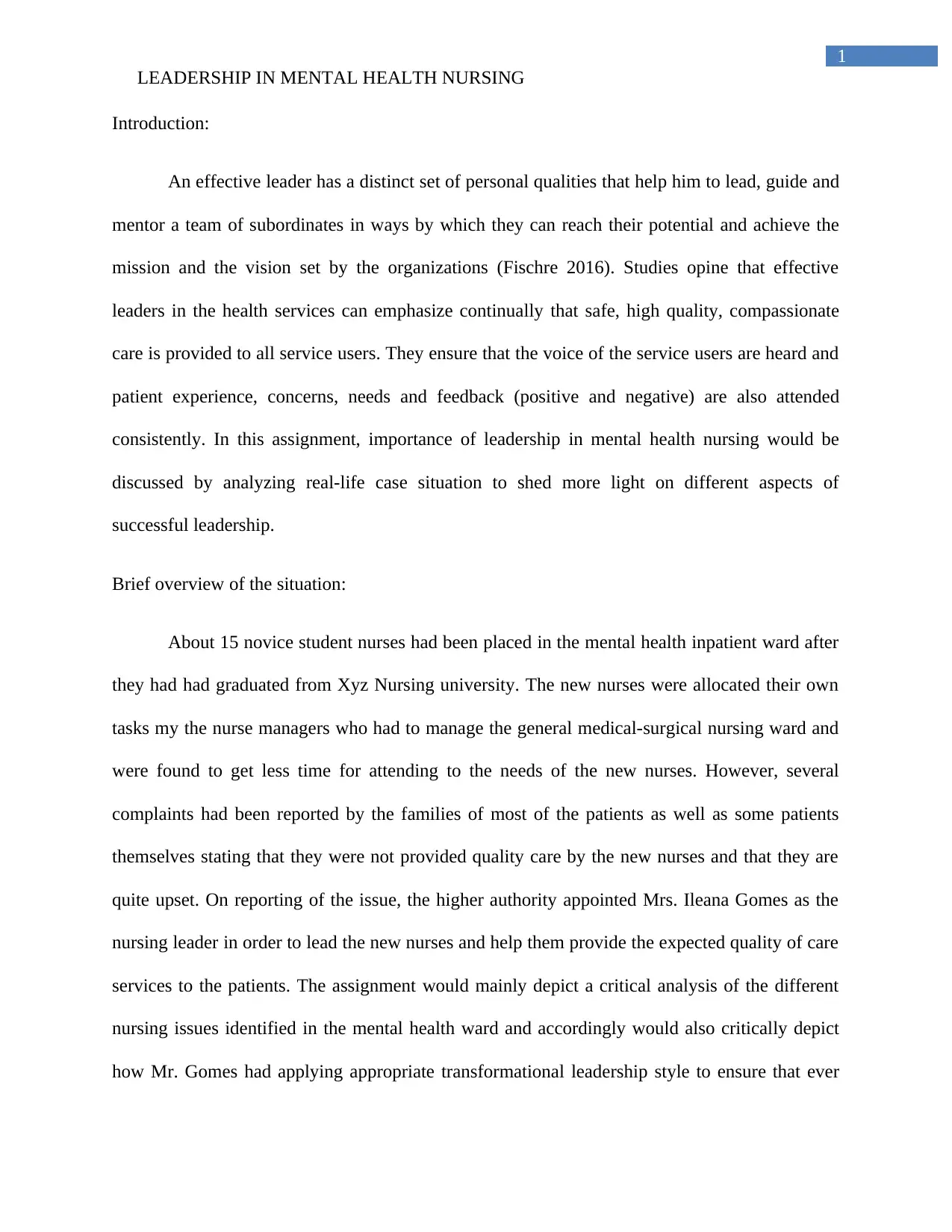
1
LEADERSHIP IN MENTAL HEALTH NURSING
Introduction:
An effective leader has a distinct set of personal qualities that help him to lead, guide and
mentor a team of subordinates in ways by which they can reach their potential and achieve the
mission and the vision set by the organizations (Fischre 2016). Studies opine that effective
leaders in the health services can emphasize continually that safe, high quality, compassionate
care is provided to all service users. They ensure that the voice of the service users are heard and
patient experience, concerns, needs and feedback (positive and negative) are also attended
consistently. In this assignment, importance of leadership in mental health nursing would be
discussed by analyzing real-life case situation to shed more light on different aspects of
successful leadership.
Brief overview of the situation:
About 15 novice student nurses had been placed in the mental health inpatient ward after
they had had graduated from Xyz Nursing university. The new nurses were allocated their own
tasks my the nurse managers who had to manage the general medical-surgical nursing ward and
were found to get less time for attending to the needs of the new nurses. However, several
complaints had been reported by the families of most of the patients as well as some patients
themselves stating that they were not provided quality care by the new nurses and that they are
quite upset. On reporting of the issue, the higher authority appointed Mrs. Ileana Gomes as the
nursing leader in order to lead the new nurses and help them provide the expected quality of care
services to the patients. The assignment would mainly depict a critical analysis of the different
nursing issues identified in the mental health ward and accordingly would also critically depict
how Mr. Gomes had applying appropriate transformational leadership style to ensure that ever
LEADERSHIP IN MENTAL HEALTH NURSING
Introduction:
An effective leader has a distinct set of personal qualities that help him to lead, guide and
mentor a team of subordinates in ways by which they can reach their potential and achieve the
mission and the vision set by the organizations (Fischre 2016). Studies opine that effective
leaders in the health services can emphasize continually that safe, high quality, compassionate
care is provided to all service users. They ensure that the voice of the service users are heard and
patient experience, concerns, needs and feedback (positive and negative) are also attended
consistently. In this assignment, importance of leadership in mental health nursing would be
discussed by analyzing real-life case situation to shed more light on different aspects of
successful leadership.
Brief overview of the situation:
About 15 novice student nurses had been placed in the mental health inpatient ward after
they had had graduated from Xyz Nursing university. The new nurses were allocated their own
tasks my the nurse managers who had to manage the general medical-surgical nursing ward and
were found to get less time for attending to the needs of the new nurses. However, several
complaints had been reported by the families of most of the patients as well as some patients
themselves stating that they were not provided quality care by the new nurses and that they are
quite upset. On reporting of the issue, the higher authority appointed Mrs. Ileana Gomes as the
nursing leader in order to lead the new nurses and help them provide the expected quality of care
services to the patients. The assignment would mainly depict a critical analysis of the different
nursing issues identified in the mental health ward and accordingly would also critically depict
how Mr. Gomes had applying appropriate transformational leadership style to ensure that ever

2
LEADERSHIP IN MENTAL HEALTH NURSING
problems faced by the new nurses are overcome by them successfully to provide high quality
care to the patients.
Issue of improper communication skills of the nurses and how it was mitigated:
The new nurses who were appointed to the mental health ward were witnessed to possess
poor communication skills. They could not communicate with the patients in an efficient manner
for which the mental health patients were not found to be comfortable to get treatment in their
presence. One of the nurses was seen to break into the room of a mental health patient without
knocking and started providing her anti-depressant dose even without describing her intervention
or asking for permission. Another of the nurse was found to be fidgety in her appearance and
asked the patient to be faster in his replies so that she can move onto the next patient. Another of
the nurses was found to be exhibiting an insensitive behavior to the death of the son of the
depressed patient and told, “You should have controlled you son’s smoking habits, if you really
would have wanted to save him”. Several such incidences made Gomes understood that the
nursing professionals were not aware of the correct procedures of undertaking therapeutic
communication with the patients and for this reason they were not able to develop an emotional
connection with the patients. The patients were unsatisfied with the treatments and their families
complained about this.
Effective therapeutic relationship development is a significant attribute of mental
healthcare services provided by the nurses to the patients. Proper nonverbal communication like
empathy and compassion are considered to be two important attributes that makes the patients
feel respected (Vaismoradi et al., 2016). The patients feel that the nurses are not judging them
about their mental health condition and that they are able to feel the suffering that the patient is
LEADERSHIP IN MENTAL HEALTH NURSING
problems faced by the new nurses are overcome by them successfully to provide high quality
care to the patients.
Issue of improper communication skills of the nurses and how it was mitigated:
The new nurses who were appointed to the mental health ward were witnessed to possess
poor communication skills. They could not communicate with the patients in an efficient manner
for which the mental health patients were not found to be comfortable to get treatment in their
presence. One of the nurses was seen to break into the room of a mental health patient without
knocking and started providing her anti-depressant dose even without describing her intervention
or asking for permission. Another of the nurse was found to be fidgety in her appearance and
asked the patient to be faster in his replies so that she can move onto the next patient. Another of
the nurses was found to be exhibiting an insensitive behavior to the death of the son of the
depressed patient and told, “You should have controlled you son’s smoking habits, if you really
would have wanted to save him”. Several such incidences made Gomes understood that the
nursing professionals were not aware of the correct procedures of undertaking therapeutic
communication with the patients and for this reason they were not able to develop an emotional
connection with the patients. The patients were unsatisfied with the treatments and their families
complained about this.
Effective therapeutic relationship development is a significant attribute of mental
healthcare services provided by the nurses to the patients. Proper nonverbal communication like
empathy and compassion are considered to be two important attributes that makes the patients
feel respected (Vaismoradi et al., 2016). The patients feel that the nurses are not judging them
about their mental health condition and that they are able to feel the suffering that the patient is
⊘ This is a preview!⊘
Do you want full access?
Subscribe today to unlock all pages.

Trusted by 1+ million students worldwide

3
LEADERSHIP IN MENTAL HEALTH NURSING
going through. Moreover, proper eye contact, gestures, touches, and similar others need to be
followed by the nurses to develop quality bonds with the patients. This helps in developing trust
and mutual respect of the patients on the nursing professionals (Lin et al., 2015). Their
participation in their care increases and this helps to make the patients feel empowered and
develop self-coping abilities on encouragement of the professionals. Hence, the nursing leaders
need to guide the novice nursing professionals in ways by which they can develop the skills in
their practice.
Mr. Gomes follow the transformational leadership style. One of the main foundations of
this leadership style is the idealized influence. Transformational leaders are not seen to lead by
intimidation as well as through predetermined command. They are seen to lead by setting of
examples. Studies are of the opinion that through the keen observation of such transformational
leadership practices, the individuals are seen to gain trust from the team members’ respect as
well as faith (Giddens, 2018). This in turn is seen to inspire the members in emulating their
admirable qualities. Such leaders are seen to have high levels of standards of moral as well as
ethical conduct and they are considered to always do the right thing (Fischer et al., 2017). They
are deeply respected by the followers who place a great deal of trust in them. They help in
providing the followers with the sense of vision as well as mission (Weng et al., 2015). Mr.
Gomes decided to lead by examples and she considered mentoring each of the nurses who had
poor communication skills. She visited the patients with each of the nurses and initiated the
communication with the patient with proper verbal and communication skills. She started
providing the nurses with hand-on-experiences so that the nurses can learn by observational
learning. She exhibited to each of the nurses how proper effective communication attributes
helped her developing an emotional bond with the patients that enhanced the participation of
LEADERSHIP IN MENTAL HEALTH NURSING
going through. Moreover, proper eye contact, gestures, touches, and similar others need to be
followed by the nurses to develop quality bonds with the patients. This helps in developing trust
and mutual respect of the patients on the nursing professionals (Lin et al., 2015). Their
participation in their care increases and this helps to make the patients feel empowered and
develop self-coping abilities on encouragement of the professionals. Hence, the nursing leaders
need to guide the novice nursing professionals in ways by which they can develop the skills in
their practice.
Mr. Gomes follow the transformational leadership style. One of the main foundations of
this leadership style is the idealized influence. Transformational leaders are not seen to lead by
intimidation as well as through predetermined command. They are seen to lead by setting of
examples. Studies are of the opinion that through the keen observation of such transformational
leadership practices, the individuals are seen to gain trust from the team members’ respect as
well as faith (Giddens, 2018). This in turn is seen to inspire the members in emulating their
admirable qualities. Such leaders are seen to have high levels of standards of moral as well as
ethical conduct and they are considered to always do the right thing (Fischer et al., 2017). They
are deeply respected by the followers who place a great deal of trust in them. They help in
providing the followers with the sense of vision as well as mission (Weng et al., 2015). Mr.
Gomes decided to lead by examples and she considered mentoring each of the nurses who had
poor communication skills. She visited the patients with each of the nurses and initiated the
communication with the patient with proper verbal and communication skills. She started
providing the nurses with hand-on-experiences so that the nurses can learn by observational
learning. She exhibited to each of the nurses how proper effective communication attributes
helped her developing an emotional bond with the patients that enhanced the participation of
Paraphrase This Document
Need a fresh take? Get an instant paraphrase of this document with our AI Paraphraser
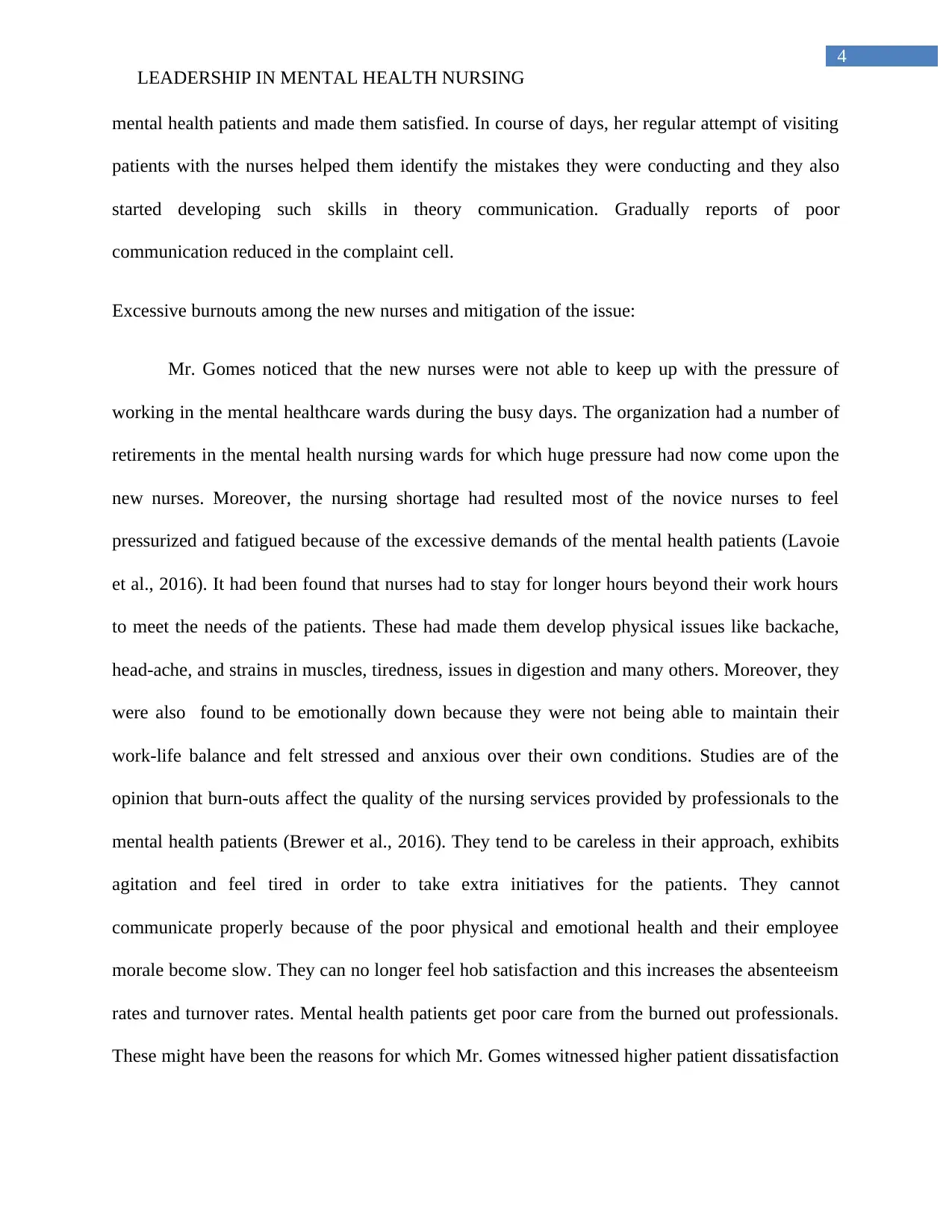
4
LEADERSHIP IN MENTAL HEALTH NURSING
mental health patients and made them satisfied. In course of days, her regular attempt of visiting
patients with the nurses helped them identify the mistakes they were conducting and they also
started developing such skills in theory communication. Gradually reports of poor
communication reduced in the complaint cell.
Excessive burnouts among the new nurses and mitigation of the issue:
Mr. Gomes noticed that the new nurses were not able to keep up with the pressure of
working in the mental healthcare wards during the busy days. The organization had a number of
retirements in the mental health nursing wards for which huge pressure had now come upon the
new nurses. Moreover, the nursing shortage had resulted most of the novice nurses to feel
pressurized and fatigued because of the excessive demands of the mental health patients (Lavoie
et al., 2016). It had been found that nurses had to stay for longer hours beyond their work hours
to meet the needs of the patients. These had made them develop physical issues like backache,
head-ache, and strains in muscles, tiredness, issues in digestion and many others. Moreover, they
were also found to be emotionally down because they were not being able to maintain their
work-life balance and felt stressed and anxious over their own conditions. Studies are of the
opinion that burn-outs affect the quality of the nursing services provided by professionals to the
mental health patients (Brewer et al., 2016). They tend to be careless in their approach, exhibits
agitation and feel tired in order to take extra initiatives for the patients. They cannot
communicate properly because of the poor physical and emotional health and their employee
morale become slow. They can no longer feel hob satisfaction and this increases the absenteeism
rates and turnover rates. Mental health patients get poor care from the burned out professionals.
These might have been the reasons for which Mr. Gomes witnessed higher patient dissatisfaction
LEADERSHIP IN MENTAL HEALTH NURSING
mental health patients and made them satisfied. In course of days, her regular attempt of visiting
patients with the nurses helped them identify the mistakes they were conducting and they also
started developing such skills in theory communication. Gradually reports of poor
communication reduced in the complaint cell.
Excessive burnouts among the new nurses and mitigation of the issue:
Mr. Gomes noticed that the new nurses were not able to keep up with the pressure of
working in the mental healthcare wards during the busy days. The organization had a number of
retirements in the mental health nursing wards for which huge pressure had now come upon the
new nurses. Moreover, the nursing shortage had resulted most of the novice nurses to feel
pressurized and fatigued because of the excessive demands of the mental health patients (Lavoie
et al., 2016). It had been found that nurses had to stay for longer hours beyond their work hours
to meet the needs of the patients. These had made them develop physical issues like backache,
head-ache, and strains in muscles, tiredness, issues in digestion and many others. Moreover, they
were also found to be emotionally down because they were not being able to maintain their
work-life balance and felt stressed and anxious over their own conditions. Studies are of the
opinion that burn-outs affect the quality of the nursing services provided by professionals to the
mental health patients (Brewer et al., 2016). They tend to be careless in their approach, exhibits
agitation and feel tired in order to take extra initiatives for the patients. They cannot
communicate properly because of the poor physical and emotional health and their employee
morale become slow. They can no longer feel hob satisfaction and this increases the absenteeism
rates and turnover rates. Mental health patients get poor care from the burned out professionals.
These might have been the reasons for which Mr. Gomes witnessed higher patient dissatisfaction
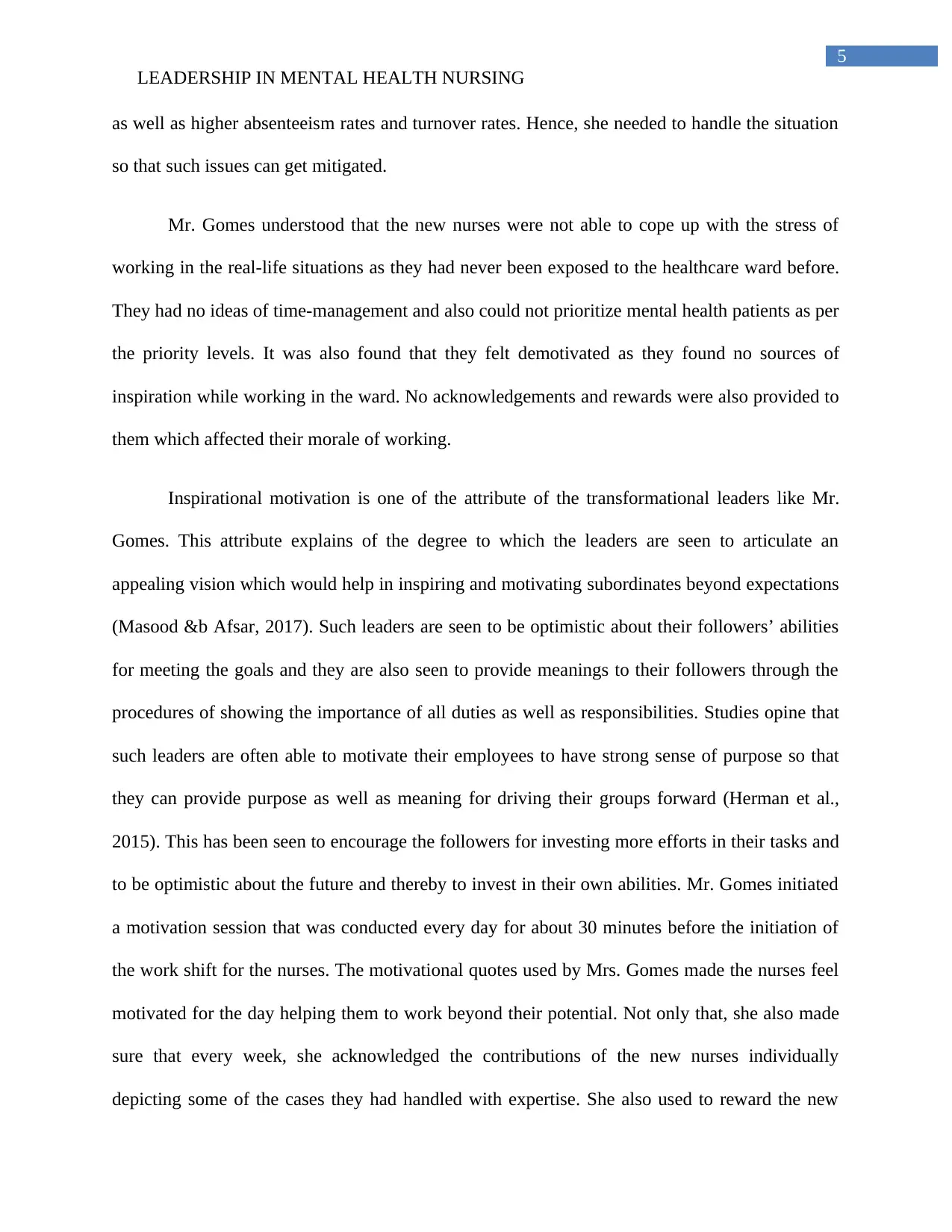
5
LEADERSHIP IN MENTAL HEALTH NURSING
as well as higher absenteeism rates and turnover rates. Hence, she needed to handle the situation
so that such issues can get mitigated.
Mr. Gomes understood that the new nurses were not able to cope up with the stress of
working in the real-life situations as they had never been exposed to the healthcare ward before.
They had no ideas of time-management and also could not prioritize mental health patients as per
the priority levels. It was also found that they felt demotivated as they found no sources of
inspiration while working in the ward. No acknowledgements and rewards were also provided to
them which affected their morale of working.
Inspirational motivation is one of the attribute of the transformational leaders like Mr.
Gomes. This attribute explains of the degree to which the leaders are seen to articulate an
appealing vision which would help in inspiring and motivating subordinates beyond expectations
(Masood &b Afsar, 2017). Such leaders are seen to be optimistic about their followers’ abilities
for meeting the goals and they are also seen to provide meanings to their followers through the
procedures of showing the importance of all duties as well as responsibilities. Studies opine that
such leaders are often able to motivate their employees to have strong sense of purpose so that
they can provide purpose as well as meaning for driving their groups forward (Herman et al.,
2015). This has been seen to encourage the followers for investing more efforts in their tasks and
to be optimistic about the future and thereby to invest in their own abilities. Mr. Gomes initiated
a motivation session that was conducted every day for about 30 minutes before the initiation of
the work shift for the nurses. The motivational quotes used by Mrs. Gomes made the nurses feel
motivated for the day helping them to work beyond their potential. Not only that, she also made
sure that every week, she acknowledged the contributions of the new nurses individually
depicting some of the cases they had handled with expertise. She also used to reward the new
LEADERSHIP IN MENTAL HEALTH NURSING
as well as higher absenteeism rates and turnover rates. Hence, she needed to handle the situation
so that such issues can get mitigated.
Mr. Gomes understood that the new nurses were not able to cope up with the stress of
working in the real-life situations as they had never been exposed to the healthcare ward before.
They had no ideas of time-management and also could not prioritize mental health patients as per
the priority levels. It was also found that they felt demotivated as they found no sources of
inspiration while working in the ward. No acknowledgements and rewards were also provided to
them which affected their morale of working.
Inspirational motivation is one of the attribute of the transformational leaders like Mr.
Gomes. This attribute explains of the degree to which the leaders are seen to articulate an
appealing vision which would help in inspiring and motivating subordinates beyond expectations
(Masood &b Afsar, 2017). Such leaders are seen to be optimistic about their followers’ abilities
for meeting the goals and they are also seen to provide meanings to their followers through the
procedures of showing the importance of all duties as well as responsibilities. Studies opine that
such leaders are often able to motivate their employees to have strong sense of purpose so that
they can provide purpose as well as meaning for driving their groups forward (Herman et al.,
2015). This has been seen to encourage the followers for investing more efforts in their tasks and
to be optimistic about the future and thereby to invest in their own abilities. Mr. Gomes initiated
a motivation session that was conducted every day for about 30 minutes before the initiation of
the work shift for the nurses. The motivational quotes used by Mrs. Gomes made the nurses feel
motivated for the day helping them to work beyond their potential. Not only that, she also made
sure that every week, she acknowledged the contributions of the new nurses individually
depicting some of the cases they had handled with expertise. She also used to reward the new
⊘ This is a preview!⊘
Do you want full access?
Subscribe today to unlock all pages.

Trusted by 1+ million students worldwide
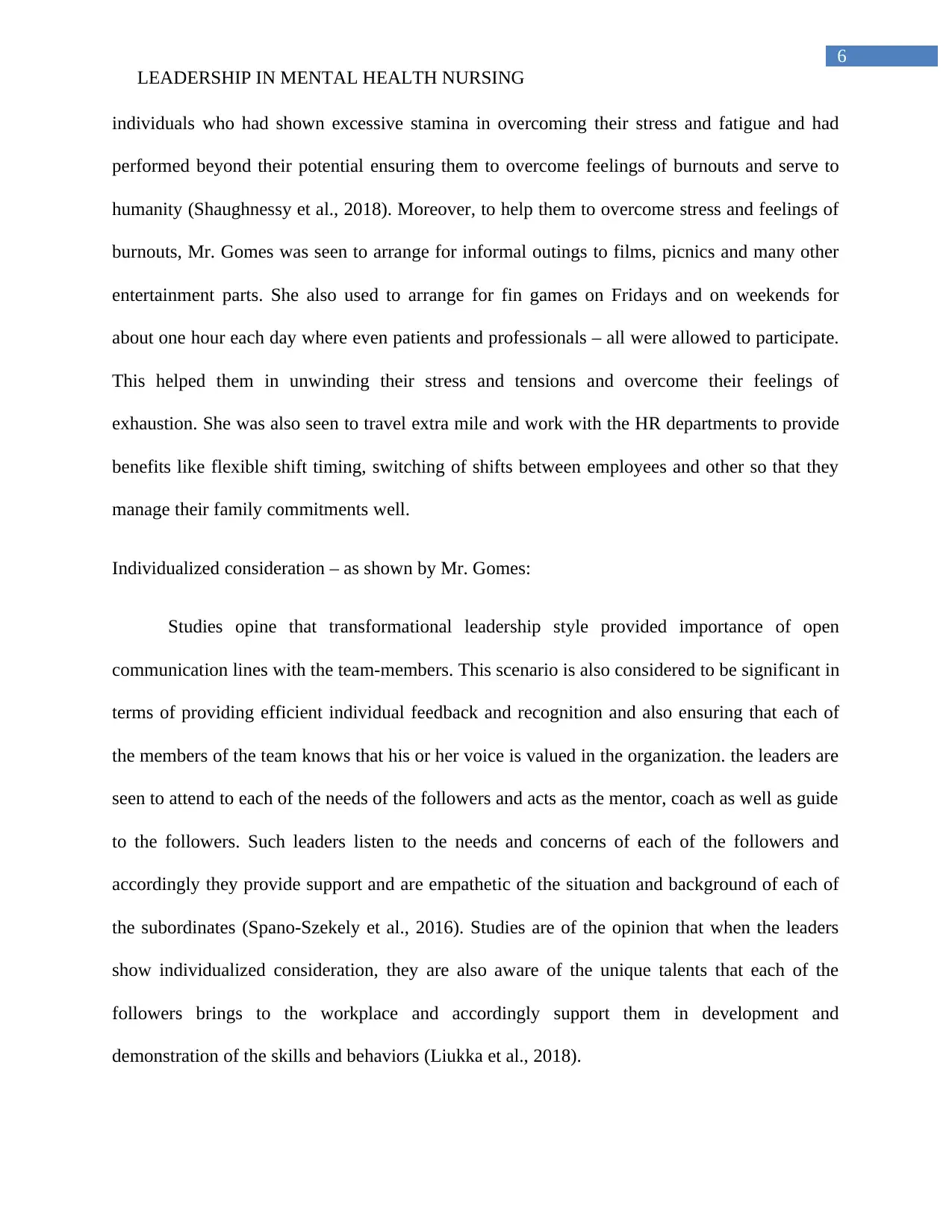
6
LEADERSHIP IN MENTAL HEALTH NURSING
individuals who had shown excessive stamina in overcoming their stress and fatigue and had
performed beyond their potential ensuring them to overcome feelings of burnouts and serve to
humanity (Shaughnessy et al., 2018). Moreover, to help them to overcome stress and feelings of
burnouts, Mr. Gomes was seen to arrange for informal outings to films, picnics and many other
entertainment parts. She also used to arrange for fin games on Fridays and on weekends for
about one hour each day where even patients and professionals – all were allowed to participate.
This helped them in unwinding their stress and tensions and overcome their feelings of
exhaustion. She was also seen to travel extra mile and work with the HR departments to provide
benefits like flexible shift timing, switching of shifts between employees and other so that they
manage their family commitments well.
Individualized consideration – as shown by Mr. Gomes:
Studies opine that transformational leadership style provided importance of open
communication lines with the team-members. This scenario is also considered to be significant in
terms of providing efficient individual feedback and recognition and also ensuring that each of
the members of the team knows that his or her voice is valued in the organization. the leaders are
seen to attend to each of the needs of the followers and acts as the mentor, coach as well as guide
to the followers. Such leaders listen to the needs and concerns of each of the followers and
accordingly they provide support and are empathetic of the situation and background of each of
the subordinates (Spano-Szekely et al., 2016). Studies are of the opinion that when the leaders
show individualized consideration, they are also aware of the unique talents that each of the
followers brings to the workplace and accordingly support them in development and
demonstration of the skills and behaviors (Liukka et al., 2018).
LEADERSHIP IN MENTAL HEALTH NURSING
individuals who had shown excessive stamina in overcoming their stress and fatigue and had
performed beyond their potential ensuring them to overcome feelings of burnouts and serve to
humanity (Shaughnessy et al., 2018). Moreover, to help them to overcome stress and feelings of
burnouts, Mr. Gomes was seen to arrange for informal outings to films, picnics and many other
entertainment parts. She also used to arrange for fin games on Fridays and on weekends for
about one hour each day where even patients and professionals – all were allowed to participate.
This helped them in unwinding their stress and tensions and overcome their feelings of
exhaustion. She was also seen to travel extra mile and work with the HR departments to provide
benefits like flexible shift timing, switching of shifts between employees and other so that they
manage their family commitments well.
Individualized consideration – as shown by Mr. Gomes:
Studies opine that transformational leadership style provided importance of open
communication lines with the team-members. This scenario is also considered to be significant in
terms of providing efficient individual feedback and recognition and also ensuring that each of
the members of the team knows that his or her voice is valued in the organization. the leaders are
seen to attend to each of the needs of the followers and acts as the mentor, coach as well as guide
to the followers. Such leaders listen to the needs and concerns of each of the followers and
accordingly they provide support and are empathetic of the situation and background of each of
the subordinates (Spano-Szekely et al., 2016). Studies are of the opinion that when the leaders
show individualized consideration, they are also aware of the unique talents that each of the
followers brings to the workplace and accordingly support them in development and
demonstration of the skills and behaviors (Liukka et al., 2018).
Paraphrase This Document
Need a fresh take? Get an instant paraphrase of this document with our AI Paraphraser
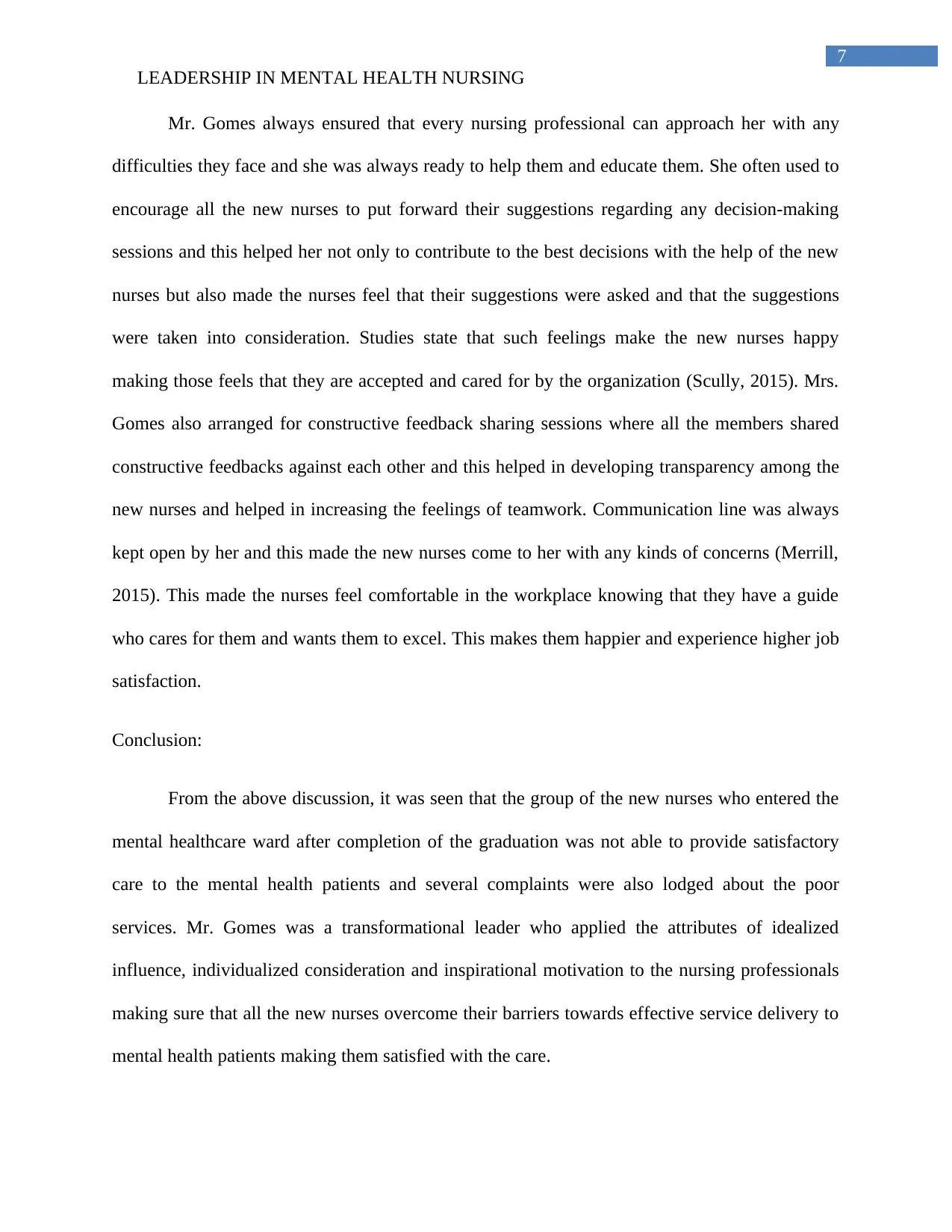
7
LEADERSHIP IN MENTAL HEALTH NURSING
Mr. Gomes always ensured that every nursing professional can approach her with any
difficulties they face and she was always ready to help them and educate them. She often used to
encourage all the new nurses to put forward their suggestions regarding any decision-making
sessions and this helped her not only to contribute to the best decisions with the help of the new
nurses but also made the nurses feel that their suggestions were asked and that the suggestions
were taken into consideration. Studies state that such feelings make the new nurses happy
making those feels that they are accepted and cared for by the organization (Scully, 2015). Mrs.
Gomes also arranged for constructive feedback sharing sessions where all the members shared
constructive feedbacks against each other and this helped in developing transparency among the
new nurses and helped in increasing the feelings of teamwork. Communication line was always
kept open by her and this made the new nurses come to her with any kinds of concerns (Merrill,
2015). This made the nurses feel comfortable in the workplace knowing that they have a guide
who cares for them and wants them to excel. This makes them happier and experience higher job
satisfaction.
Conclusion:
From the above discussion, it was seen that the group of the new nurses who entered the
mental healthcare ward after completion of the graduation was not able to provide satisfactory
care to the mental health patients and several complaints were also lodged about the poor
services. Mr. Gomes was a transformational leader who applied the attributes of idealized
influence, individualized consideration and inspirational motivation to the nursing professionals
making sure that all the new nurses overcome their barriers towards effective service delivery to
mental health patients making them satisfied with the care.
LEADERSHIP IN MENTAL HEALTH NURSING
Mr. Gomes always ensured that every nursing professional can approach her with any
difficulties they face and she was always ready to help them and educate them. She often used to
encourage all the new nurses to put forward their suggestions regarding any decision-making
sessions and this helped her not only to contribute to the best decisions with the help of the new
nurses but also made the nurses feel that their suggestions were asked and that the suggestions
were taken into consideration. Studies state that such feelings make the new nurses happy
making those feels that they are accepted and cared for by the organization (Scully, 2015). Mrs.
Gomes also arranged for constructive feedback sharing sessions where all the members shared
constructive feedbacks against each other and this helped in developing transparency among the
new nurses and helped in increasing the feelings of teamwork. Communication line was always
kept open by her and this made the new nurses come to her with any kinds of concerns (Merrill,
2015). This made the nurses feel comfortable in the workplace knowing that they have a guide
who cares for them and wants them to excel. This makes them happier and experience higher job
satisfaction.
Conclusion:
From the above discussion, it was seen that the group of the new nurses who entered the
mental healthcare ward after completion of the graduation was not able to provide satisfactory
care to the mental health patients and several complaints were also lodged about the poor
services. Mr. Gomes was a transformational leader who applied the attributes of idealized
influence, individualized consideration and inspirational motivation to the nursing professionals
making sure that all the new nurses overcome their barriers towards effective service delivery to
mental health patients making them satisfied with the care.

8
LEADERSHIP IN MENTAL HEALTH NURSING
References:
Brewer, C. S., Kovner, C. T., Djukic, M., Fatehi, F., Greene, W., Chacko, T. P., & Yang, Y.
(2016). Impact of transformational leadership on nurse work outcomes. Journal of
advanced nursing, 72(11), 2879-2893.
Fischer, S. A. (2016). Transformational leadership in nursing: a concept analysis. Journal of
Advanced Nursing, 72(11), 2644-2653.
Fischer, S. A. (2017). Transformational leadership in nursing education: Making the
case. Nursing science quarterly, 30(2), 124-128.
Giddens, J. (2018). Transformational leadership: What every nursing dean should know. Journal
of Professional Nursing, 34(2), 117-121.
Herman, S., Gish, M., & Rosenblum, R. (2015). Effects of nursing position on transformational
leadership practices. Journal of Nursing Administration, 45(2), 113-119.
Lavoie‐Tremblay, M., Fernet, C., Lavigne, G. L., & Austin, S. (2016). Transformational and
abusive leadership practices: impacts on novice nurses, quality of care and intention to
leave. Journal of advanced nursing, 72(3), 582-592.
Lin, P. Y., MacLennan, S., Hunt, N., & Cox, T. (2015). The influences of nursing
transformational leadership style on the quality of nurses’ working lives in Taiwan: a
cross-sectional quantitative study. BMC nursing, 14(1), 33.
Liukka, M., Hupli, M., & Turunen, H. (2018). How transformational leadership appears in action
with adverse events? A study for Finnish nurse manager. Journal of nursing
management, 26(6), 639-646.
LEADERSHIP IN MENTAL HEALTH NURSING
References:
Brewer, C. S., Kovner, C. T., Djukic, M., Fatehi, F., Greene, W., Chacko, T. P., & Yang, Y.
(2016). Impact of transformational leadership on nurse work outcomes. Journal of
advanced nursing, 72(11), 2879-2893.
Fischer, S. A. (2016). Transformational leadership in nursing: a concept analysis. Journal of
Advanced Nursing, 72(11), 2644-2653.
Fischer, S. A. (2017). Transformational leadership in nursing education: Making the
case. Nursing science quarterly, 30(2), 124-128.
Giddens, J. (2018). Transformational leadership: What every nursing dean should know. Journal
of Professional Nursing, 34(2), 117-121.
Herman, S., Gish, M., & Rosenblum, R. (2015). Effects of nursing position on transformational
leadership practices. Journal of Nursing Administration, 45(2), 113-119.
Lavoie‐Tremblay, M., Fernet, C., Lavigne, G. L., & Austin, S. (2016). Transformational and
abusive leadership practices: impacts on novice nurses, quality of care and intention to
leave. Journal of advanced nursing, 72(3), 582-592.
Lin, P. Y., MacLennan, S., Hunt, N., & Cox, T. (2015). The influences of nursing
transformational leadership style on the quality of nurses’ working lives in Taiwan: a
cross-sectional quantitative study. BMC nursing, 14(1), 33.
Liukka, M., Hupli, M., & Turunen, H. (2018). How transformational leadership appears in action
with adverse events? A study for Finnish nurse manager. Journal of nursing
management, 26(6), 639-646.
⊘ This is a preview!⊘
Do you want full access?
Subscribe today to unlock all pages.

Trusted by 1+ million students worldwide
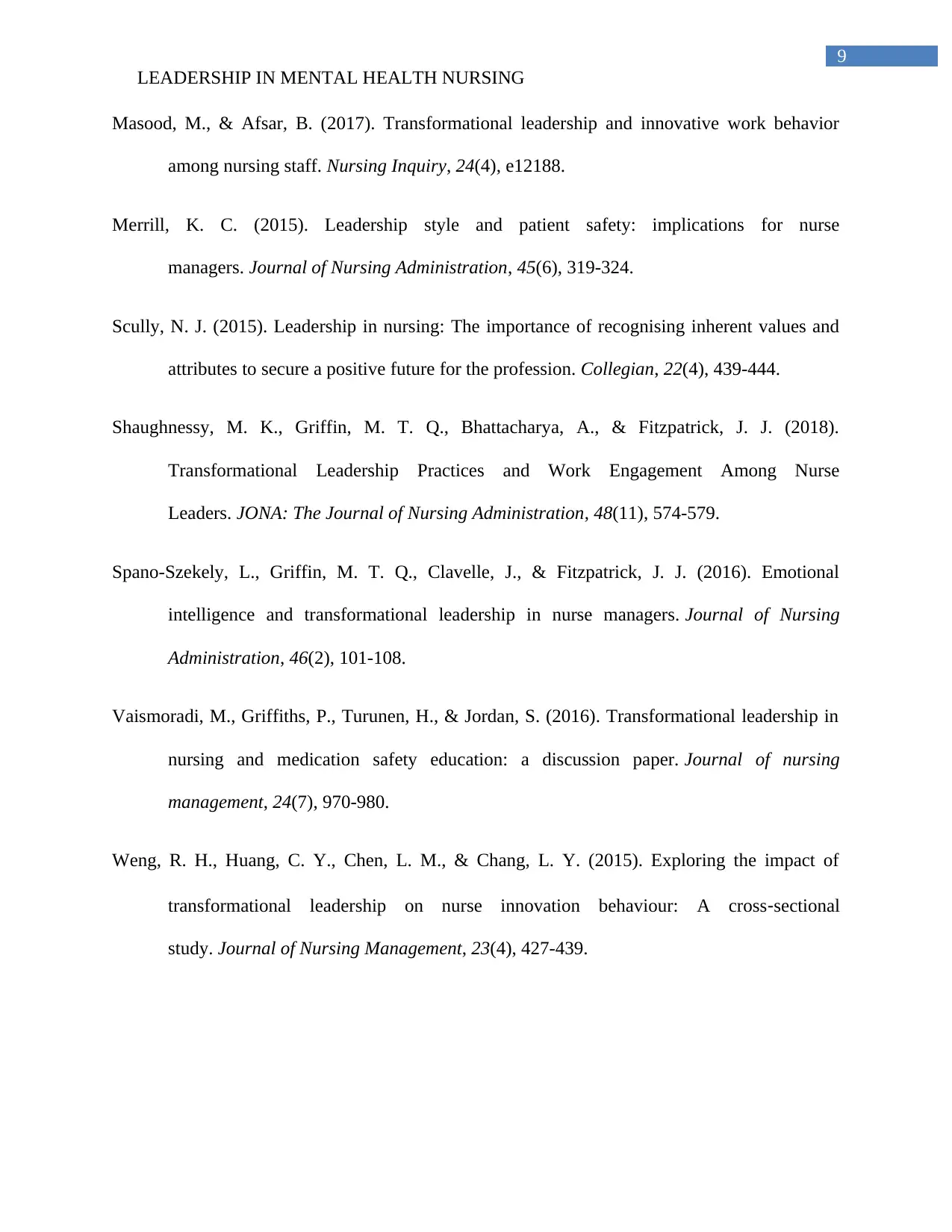
9
LEADERSHIP IN MENTAL HEALTH NURSING
Masood, M., & Afsar, B. (2017). Transformational leadership and innovative work behavior
among nursing staff. Nursing Inquiry, 24(4), e12188.
Merrill, K. C. (2015). Leadership style and patient safety: implications for nurse
managers. Journal of Nursing Administration, 45(6), 319-324.
Scully, N. J. (2015). Leadership in nursing: The importance of recognising inherent values and
attributes to secure a positive future for the profession. Collegian, 22(4), 439-444.
Shaughnessy, M. K., Griffin, M. T. Q., Bhattacharya, A., & Fitzpatrick, J. J. (2018).
Transformational Leadership Practices and Work Engagement Among Nurse
Leaders. JONA: The Journal of Nursing Administration, 48(11), 574-579.
Spano-Szekely, L., Griffin, M. T. Q., Clavelle, J., & Fitzpatrick, J. J. (2016). Emotional
intelligence and transformational leadership in nurse managers. Journal of Nursing
Administration, 46(2), 101-108.
Vaismoradi, M., Griffiths, P., Turunen, H., & Jordan, S. (2016). Transformational leadership in
nursing and medication safety education: a discussion paper. Journal of nursing
management, 24(7), 970-980.
Weng, R. H., Huang, C. Y., Chen, L. M., & Chang, L. Y. (2015). Exploring the impact of
transformational leadership on nurse innovation behaviour: A cross‐sectional
study. Journal of Nursing Management, 23(4), 427-439.
LEADERSHIP IN MENTAL HEALTH NURSING
Masood, M., & Afsar, B. (2017). Transformational leadership and innovative work behavior
among nursing staff. Nursing Inquiry, 24(4), e12188.
Merrill, K. C. (2015). Leadership style and patient safety: implications for nurse
managers. Journal of Nursing Administration, 45(6), 319-324.
Scully, N. J. (2015). Leadership in nursing: The importance of recognising inherent values and
attributes to secure a positive future for the profession. Collegian, 22(4), 439-444.
Shaughnessy, M. K., Griffin, M. T. Q., Bhattacharya, A., & Fitzpatrick, J. J. (2018).
Transformational Leadership Practices and Work Engagement Among Nurse
Leaders. JONA: The Journal of Nursing Administration, 48(11), 574-579.
Spano-Szekely, L., Griffin, M. T. Q., Clavelle, J., & Fitzpatrick, J. J. (2016). Emotional
intelligence and transformational leadership in nurse managers. Journal of Nursing
Administration, 46(2), 101-108.
Vaismoradi, M., Griffiths, P., Turunen, H., & Jordan, S. (2016). Transformational leadership in
nursing and medication safety education: a discussion paper. Journal of nursing
management, 24(7), 970-980.
Weng, R. H., Huang, C. Y., Chen, L. M., & Chang, L. Y. (2015). Exploring the impact of
transformational leadership on nurse innovation behaviour: A cross‐sectional
study. Journal of Nursing Management, 23(4), 427-439.
1 out of 10
Related Documents
Your All-in-One AI-Powered Toolkit for Academic Success.
+13062052269
info@desklib.com
Available 24*7 on WhatsApp / Email
![[object Object]](/_next/static/media/star-bottom.7253800d.svg)
Unlock your academic potential
Copyright © 2020–2025 A2Z Services. All Rights Reserved. Developed and managed by ZUCOL.




